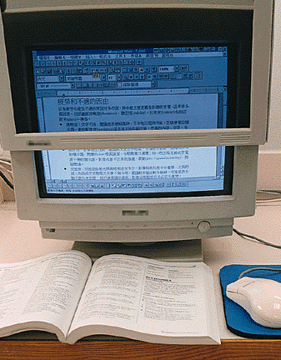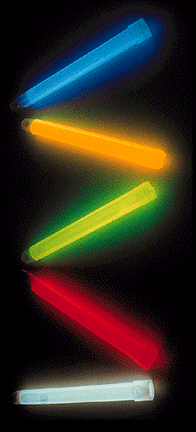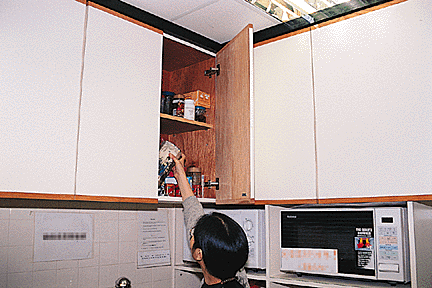Do computer monitors emit harmful radiations and cause short-sightedness to the eye?
If so, can screen filters - an array of these products have surfaced in the market - protect the user from such adverse effects?
To probe into these questions, the Consumer Council has launched a test on 20 models of monitor screen filters with prices ranging from under $100 to a high $800.
The results of the test, published in the latest (251) issue of the Council's monthly magazine 'CHOICE', are quite an eye-opener to both potential buyers and current users.
The report noted that claims of the hazard of radiations from computer monitors are not well founded although they are frequently advertised on products of monitor screen filters.
Computer monitors do emit some amount of VLF (Very Low Frequency) and ELF (Extremely Low Frequency) electromagnetic radiations. But these are entirely different from X-ray or gamma ray which are of high energy level.
There is yet no sufficient evidence to prove any adverse effect of VLF or ELF radiations to the human body.
 In any case, the Council's test revealed that none of the 20 monitor screen filter samples could safely protect users from such radiations whether or not they are harmful.
In any case, the Council's test revealed that none of the 20 monitor screen filter samples could safely protect users from such radiations whether or not they are harmful.
According to the test, VLF and ELF radiations consist of two components: electric field and magnetic field. But while many samples could really block the electric field component, none could have any significant effect in reducing the magnetic field.
The test has also examined the optical characteristics of these filters: colour shift, anti-reflection, light transmittance and contrast improvement.
The results showed great variations in their performance. Though most filters could reduce reflection from the monitor screen surface and raise the image contrast ratio, many actually introduced other problems, i.e. dark screen and reflections from the filter itself.
The report noted that many computer monitors are carefully designed for use in general lighting conditions. New computers also usually adopt flat square tube that will reduce reflections. Users therefore may use these monitors directly without adding any unnecessary third party accessory.
Consumers are advised that to avoid reflection the best way is simply to remove or shade the light source causing the reflection. Users may also move or turn the monitor to obtain best results.
Working in front of a computer monitor for a long time does cause eye fatigue easily. It also increases the chance of developing short-sightedness of the eye.
But the best solution is for users to practise good computer using habit such as taking more rest and allowing the eyes to relax or focus on far distance.
 Come Mid-Autumn Festival tonight (September 16) and a myriad of lights will glow in celebration of this festival of lanterns.
Come Mid-Autumn Festival tonight (September 16) and a myriad of lights will glow in celebration of this festival of lanterns.
But some of these lights are not from the burning candles of traditional lanterns. They are produced by a modern day gadget known as the chemical light stick.
By bending the light stick, the chemicals inside the plastic tube will react and emit a characteristic glow - green, yellow, white, etc.
Such light sticks are also popular in pop concerts.
But the safety of the product has been brought into question. This follows a recent accident in which a secondary student bended a light stick and the chemical splashed into the student's eyes. Fortunately, no damage was caused to the student's vision.
8 models of chemical light stick of different colours and 1 of stick-on button-type were put to a test in accordance with the relevant standard stipulated in the Toys and Children's Products Safety Ordinance.
The samples were tested for their (a) physical properties (sharp point, sharp edge), (b) flammability and (c) soluble heavy metals from the plastic jacket. All samples were found to be in compliance with the standard categories but 4 models lacked the required marking of manufacturer/agent address.
The samples were also tested to examine if their chemical content will leak out under adverse condition. 5 of the models were found to have samples (1 out of 3 each) leaking as a result of continuous bending of the light stick after activation (light emission).
The Council will conduct further tests on the chemical content of these products to ascertain if it is toxic or harmful.
According to literature research, a light stick is likely to contain quite a number of organic chemicals such as fluorescer, solvent and reactants and some of them may be harmful and can cause irritation to the skin and eyes. Therefore, if contact accidentally, one must rinse with copious amount of water.
Parents are advised not to let children aged under 5 years to play with such a chemical light stick alone without close supervision. In order to avoid leakage, users are advised not to bend the light stick again after activation. When the light stick ceases lighting, parents should dispose it immediately to prevent abusive use by their children.
According to the latest Consumer Council's annual price survey, the increase for primary and secondary textbooks was 9.33% and 8.85% respectively.
The extent of increase this year is however less than that of last year which recorded a rise of 12.44% and 11.23% respectively.
But in absolute monetary terms, the burden for parents is by no means any less.
For the primary school sector, the textbook expenditure is close to $1,000, on average, a student but in the case of a Primary 2 pupil, a change of syllabus caused a drastic increase to $1,006, up by 17.56% from last year.
For the secondary school sector, it is more than $1,700, on average, for a student but in the case of a Form 4 student in the science stream, for instance, the average cost reaches a hefty $2,200.
The survey found that the accumulated increase for the past 3 years was 41.74% and 38.31% for primary and secondary textbooks respectively.
This is considerably higher than the accumulated increase in the Consumer Price Index CPI (A) of 23.28% for the corresponding period..
 When shopping for a mortgage loan, it's not just the interest rate or the repayment amount and number of instalments that you should be solely concerned with.
When shopping for a mortgage loan, it's not just the interest rate or the repayment amount and number of instalments that you should be solely concerned with.
There are other fees and charges that you will do well to pay heed and compare. For, depending on which bank you ultimately choose, the difference could be potentially substantial.
This was borne out in a Consumer Council survey of 23 banks providing mortgage loans to home buyers on such charges as valuation fee, handling fee, late payment charge and prepayment penalty.
Valuation Fee
The survey shows that property valuation on which a bank will base to determine the amount of mortgage loan to grant, is generally provided through: (a) verbal, (b) brief, or (c) full report.
The majority of banks do provide free verbal valuation service. But for a brief report, the valuation fee is a minimum $100 while that of a full valuation report from $800 onwards.
Some banks require no valuation fee which is already covered in the handling fee as these banks operate their own valuation without the need of outside surveyors.
Valuation of a property depends on many factors such as the upkeeping and age of the building as well as its prevailing market value. Prospective buyers of flats of older age are advised to first seek a verbal valuation from a bank in mind before paying a deposit for the purchase to ensure the bank will lend the amount you apply for.
Handling Fee
Not every bank charges a handling fee. To be competitive, some banks in fact waive the handling fee, while some will refund the handling fee provided the application for mortgage loan is successfully approved.
For most banks, the handling fee charged is generally from $1,000 onwards. But some banks compute the handling fee according to a percentage of the mortgage loan, i.e. from 0.25% to 0.5%. That means for every $1 million borrowed, the handling fee is from $2,500 to $5,000. The bigger the loan the higher the handling fee.
Late Payment Charge
The calculation method adopted for such charge varies from bank to bank, according to the survey.
Most banks will use the same interest rate charged for the mortgage loan to compute the late payment charge - on a daily, 15-day or monthly basis. A few will collect from 1% to 3% of the instalment payment in arrears as late charge.
But 2 of the banks surveyed demand, in addition to the daily interest charge on late payment, also a fixed penalty of $80 and $200 respectively. One bank claims to waive any immediate late payment charge but this may result in the number of instalments being extended eventually.
Consumers are advised to compare carefully as some banks are more stringent than others in the late payment charge. It may sometimes be an oversight on your part even though you have no intention to delay repayment but that does not stop the banks from charging you extra just the same.
Prepayment Penalty
The survey reveals considerable differences in dealing with cases of early repayment within the first 12 months of the mortgage.
Some charge a prepayment penalty of 2% to 3% of the original mortgage loan or the outstanding balance. Or, alternatively, a fixed sum of $30,000 to $50,000. Others charge interests of 2 to 3 months on the original loan or its balance.
But some banks have a different approach. They charge a 6% fee of the loan for prepayment within the first half (1 to 6 months) of the first year of the mortgage or a 3% fee within the second half (7 to 12 months) of the year.
For prepayment after the first year, some banks will simply require the borrowers to give one-month advance notice. But several banks demand an extra charge for prepayment even after 2 or 3 year.
If you have in mind to change your flat in the near future, you will do well to enquire and understand clearly from requirements on prepayment penalty.
 Have your ever imagined that the furniture in your home could be a source of indoor air pollution?
Have your ever imagined that the furniture in your home could be a source of indoor air pollution?
If you have newly bought furniture that is made of pressed-wood with urea-formaldehyde resins used as adhesives in plywood, particle board and fibreboard, the chances of pollution are great.
If you feel irritation to the eye and respiratory tract, it is almost certain that the furniture is emitting a colourless gas with pungent odour called formaldehyde that is polluting the air.
Besides such wood furniture, formaldehyde is emitted also from building materials, some cosmetics and textile fabrics such as permanent-press clothing and drapes.
Exposure to low-to-moderate levels of formaldehyde in air can cause temporary burning or itching of the eye and nose, sore or burning throat.
The International Agency for Research of Cancer has classified formaldehyde as a probable human carcinogen. The World Health Organisation's indoor air guideline for formaldehyde is 100 m g/m3.
A household formaldehyde survey conducted in 1995 by the Environmental Protection Department revealed that the average concentration of formaldehyde was 50 m g/m3. About 5% of the surveyed premises had concentrations higher than the World Health Organization's guideline.
In this September issue of 'CHOICE' are provided tips to reduce formaldehyde exposure:
- Increase the ventilation of premises by opening the window, especially with new furniture or new premises.
- Furniture covered fully by laminated or water-repellent finish can reduce formaldehyde emissions than those bare-pressed wood products.
- Reducing humidity and temperature on hot and humid days will help to reduce indoor formaldehyde levels.
The industries are urged to use formaldehyde resin with care observing the relevant safety standards in force elsewhere.
The International Code of Marketing of Breast-milk Substitutes is not being strictly observed in Hong Kong.
The Consumer Council has conducted a survey on infant milk powder, information materials and various items to investigate if they are in compliance of the international code. The results indicate that most fail to fully comply with the code.
Considering that infant formulas should be made accessible when mothers choose not to breastfeed or unable to breastfeed due to medical reasons, the Council strongly believes that breast-milk substitutes should not be marketed or distributed in ways that may interfere with the protection and promotion of breast-feeding.
The Government is urged to provide more public education on breast-feeding. More nursing facilities at the workplace, including at schools and hospitals are also needed to make breast-feeding a more feasible choice for mothers.



